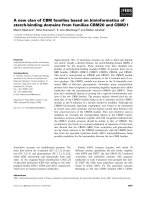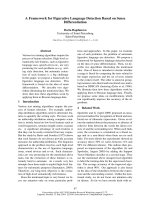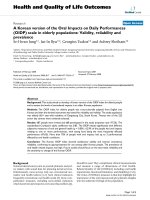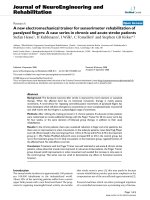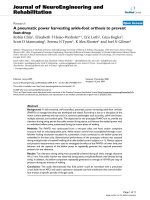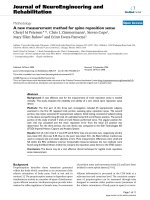Báo cáo hóa học: "A New Repeating Color Watermarking Scheme Based on Human Visual Model" doc
Bạn đang xem bản rút gọn của tài liệu. Xem và tải ngay bản đầy đủ của tài liệu tại đây (1.7 MB, 8 trang )
EURASIP Journal on Applied Signal Processing 2004:13, 1965–1972
c
2004 Hindawi Publishing Corporation
A New Repeating Color Watermarking Scheme
Based on Human Visual Model
Chwei-Shyong Tsai
Depar tment of Management Information System, National Chung Hsing University, Taichung 402, Taiwan
Email:
Chin-Chen Chang
Department of Computer Scie nce and Information Engineering, National Chung Cheng University, Chiayi 621, Taiwan
Email:
Received 26 November 2001; Revised 6 March 2004; Recommended for Publication by Yung-Chang Chen
This paper proposes a human-visual-model-based scheme that effectively protects the intellectual copyright of digital images. In
the proposed method, the theory of the visual secret sharing scheme is used to create a master watermark share and a secret wa-
termark share. The watermark share is kept secret by the owner. The master watermark share is embedded into the host image
to generate a watermarked image based on the human visual model. The proposed method conforms to all necessary conditions
of an image watermarking technique. After the watermarked image is put under various attacks such as lossy compression, ro-
tating, sharpening, blurring, and cropping, the experimental results s how that the extracted digital watermar k from the attacked
watermarked images can still be robustly detected using the proposed method.
Keywords and phrases: secret sharing, digital watermark, human visual model.
1. INTRODUCTION
With the improvement of telecommunications, more and
more people process, transmit, and store digital media via
Internet.However,problemssuchasillegaluse,tamper-
ing, and forgery occur that not only violate copyright laws
but also do harm to the monetary profits of the copyright
owners. Therefore, the protection of the intellectual prop-
erty for digital media has become an important issue. Re-
cently, digital watermarking has successfully provided the
methods to guard the intellectual property rights of digital
media, and some excellent research results have been pub-
lished [1, 2, 3, 4, 5, 6, 7, 8, 9, 10, 11, 12, 13, 14, 15, 16, 17,
18].
To effectively protect the copyright of the digital images,
a successful digital watermarking technique must possess the
following four characteristics [17, 18].
(1) Watermarking must not reveal any hint of the digital
watermark; that is, the watermarked image must not visually
differ from the host image. This achieves the goal of invisible
embedding.
(2) The host image is unnecessary when verifying the
copyright process that detects the watermark from water-
marked image. This eliminates the complexity of the process
and saves extra space for host image storage.
(3) Even if the embedding and verifying processes are
known, unauthorized users still cannot remove and detect
the digital watermark from the watermarked image, and this
achieves the goal of secure embedding.
(4) When pur posely enhancing the quality of the water-
marked image or when damage occurs so that the water-
marked image may be processed by some kind of operation
such as lossy JPEG compression, blurring, sharpening, rotat-
ing, and cropping, the copyright verification procedure can
still distinguish the identifiable digital watermark from the
modified watermarked image, and this achieves the goal of
robust embedding.
In this paper, the proposed watermarking technique uses
color digital watermarking to provide a better visual effect.
It combines the theory of visual cryptography and the tech-
nology of the human visual model to embed/extract water-
marks. The main feature of visual cryptography is trans-
forming secret message into transparencies (called shares)
and sending the shares to message receivers. When recover-
ing the secret message by stacking all transparencies, the re-
ceiver can obtain it without requiring any calculations. In ad-
dition, visual cryptography has proven to be perfectly secure.
The proposed technique uses visual cryptog raphy to produce
a matching master watermark share and a shadow water-
mark share. The master watermark share is created according
1966 EURASIP Journal on Applied Signal Processing
to the digital host image; on the other h and, the shadow
watermark share is created based on the master watermark
share and its related digital watermark. The master water-
mark share is open to the public, while the shadow water-
mark share is kept secret by the copyright owner. Human
visual model technology is used to determine the number
of bits that can be modified without decreasing the qual-
ity of the image. Thus the watermarked image created us-
ing the watermark embedding process to embed the dig-
ital watermark into the host image has such good qual-
ity that human vision cannot determine that message is
contained inside. When identifying ownership, the water-
mark identification process can recover the embedded wa-
termark by calculating the shadow watermark share given
by the owner and the master watermark share derived from
the watermarked image to ensure the legality of owner-
ship.
In this paper, the proposed technique can create the
matching shadow watermark share of each watermark ac-
cording to different digital watermarks. Therefore, it is a mul-
tiple watermarking technique. The human visual model can
be used to achieve the goal of invisible watermarking. Fur-
thermore, the embedded watermark cannot be derived from
the analysis using statistical methods and it is difficult to re-
move because of the perfect securely feature of visual cryp-
tography.
2. HUMAN VISUAL MODEL
In 1996, a human visual model for differential pulse code
modulation (DPCM) was proposed by Kuo and Chen [19].
They took Weber’s law [20] into consideration in their
model. Later, they applied another scheme based on the
model of vector quantization (VQ) image compression [21].
The purpose of the human visual model is to evaluate the
sensitivity of the human eyes to a luminance against a back-
ground. To achieve this goal, a technique called contrast
function in the gray-valued spatial domain (from 0 to 255)
is used.
The two researchers constructed the contrast function
C(x) from the combination of a bright background and a
dark one. Thus, there are two definitions of C(x) according
to the background B.HereB is the mean of the gray values in
the background. For the br ight background (B
≥ 128), C(x)
is defined as follows:
C(x) =
ln
c
1
×
c
L
− x
c
L
×
127.5 −
x − c
1
,0≤ x<128,
ln
x − c
1
×
x − c
H
c
1
×
255 − c
H
, 128 ≤ x ≤ 255,
(1)
where c
1
is a constant and is equal to 127.5/2, c
L
= 128/
(1−e
−k
), and c
H
= (128−255e
−k
)/(1−e
−k
). Here k is defined
by k = 2.5/(1 + e
(255−B)/55
).
The other definition of C(x) for the dark background
(B<128) is
C(x)
=
ln
c
1
× c
L
127.5−
x−c
1
×
c
L
−x
,0≤ x<128,
ln
x−c
1
×
255−c
H
c
1
×
x−c
H
, 128 ≤ x ≤ 255,
(2)
where c
1
is again a constant and is equal to 127.5/2, c
L
=
−128e
k
/(1 − e
k
), and c
H
= (255 − 128e
k
)/(1 − e
k
). Here k is
defined by k = 2.5/(1 + e
B/25
).
In our proposed method, the contrast function is used
to assess the sensitivity of an image block. The sensitivity of
each pixel x in a block is measured via (1)or(2) based on the
mean of the block (background). The evaluated sensitivity
points out the number of bits of pixel x would be changed.
It will be difficult for the ordinary human eye to notice the
change.
3. THE PROPOSED WATERMARKING SCHEME
For a specific digital image in need of protection, the co-
operative manufacturer and individuals (called participants)
owning the image copyright embed their digital color wa-
termarks into it. When using the proposed method to em-
bed these digital watermarks, a permutation with pseudoran-
dom number generator (PRNG) and a master watermark is
first created. Then each matching shadow watermark share is
created based on the corresponding digital watermark. The
shadow watermark share is derived by combining the mas-
ter watermark share and the information from its match-
ing digital color watermark. Finally, the shadow watermark
share is given to the related participant and kept privately
for use in the future when declaring the legal copyright own-
ership. When one of the participants needs to identify the
copyright, an unbiased third party will stack the master wa-
termark share derived from the digital image as well as the
permuted shadow watermark share from the possible copy-
right owner together and calculate both of them to recover
the digital watermark possessing the copyright information.
The proposed scheme can effectively identify the watermark
to protect the intellectual property rights of the image.
3.1. Watermark embedding process
For the digital host image H needing protection and the dig-
ital watermark representing its copyright information W, H
is a gray-value image and W is a color image. In the proposed
method, the colors in W include white, red, green, and blue.
We defin e H and W separately as follows:
H
=
HP
ij
| 0 ≤ HP
ij
≤ 255, 0 ≤ i ≤ N
1
,0≤ j ≤ N
2
,
W =
WP
uv
| WP
uv
∈
(255, 0,0), (0, 255, 0),
(0, 0, 255), (255, 255, 255)
,
0 ≤ u ≤ M
1
,0≤ v ≤ M
2
.
(3)
New Repeating Color Watermarking Based on HVM 1967
Table 1: The generation rule of pattern P
ij
.
The interval of
¯
x
ij
P
ij
[0, 63]
[64, 127]
[128, 191]
[192, 255]
Generally, the size of the watermark image is smaller than
that of the host image. Thus let M
1
<N
1
and M
2
<N
2
.
The proposed watermark embedding process mainly in-
cludes the master watermark share production procedure,
the shadow watermark share production procedure, and the
human-visual-based embedding procedure. The master wa-
termark share production procedure generates master wa-
termark share MS according to H, and the shadow water-
mark share production procedure combines MS and W to
generate shadow w atermark share SS. Note that in order
to increase the security, a secret key SK is used to be the
seed of PRNG and PRNG(SK)isappliedtopermuteall
pixels of W. And the inverse permutation is applied dur-
ing the watermark verification process to reveal the origi-
nal secret. Finally, the human-v isual-based embedding pro-
cedure is used to generate watermarked image H
.Weillus-
trate these three procedures in detail in the following subsec-
tions.
3.1.1. Master shadow share production
Because watermark image W is smaller than host image H,
the proposed method divides H into many subimages of
the same size H
i
’s, and lets every subimage H
i
correspond
to W.Here,leteveryH
i
contain n × n pixels and H =
{H
1
, H
2
, , H
N
1
/n×N
2
/n
}. When mapping each subimage
H
i
to W,firstH
i
is divided into blocks HB
ij
’s such that each
HB
ij
contains q
1
×q
2
pixels, where j = 1, 2, , n×n/q
1
×q
2
,
q
1
= n/M
1
,andq
2
= n/M
2
. Next, calculate the mean X
ij
of each HB
ij
,0 ≤ X
ij
≤ 255. Then use the X
ij
of each
HB
ij
to create a pattern P
ij
according to a certain rule.
Table 1 shows the rules of how to create P
ij
.EveryP
ij
is
3 × 3 in size and contains 5 black pixels and 4 white pix-
els. We divide the range [0, 255] in w hich all the possible
values of X
ij
may appear in 4 intervals, and define a spe-
cific P
ij
for each interval. For example, if X
ij
= 159, the
pattern to which HB
ij
corresponds is defined by the interval
[128, 191].
After applying these rules to find the corresponding pat-
ternsforallblocksHB
ij
’s in every H
i
, the proposed method
will combine all the patterns derived from H
i
’s to make up
the master watermark share MS of H.
Table 2: An example of CT.
Color No.
White 4
Red 3
Green 2
Blue 1
P
ij
=
S
ij
=
Figure 1: An example of P
ij
and S
ij
.
3.1.2. Producing shadow watermark share procedure
The size of shadow watermark share SS is the same as that
of MS.EveryP
ij
in MS corresponds to a 3 × 3patterninSS
defined as S
ij
. P
ij
and the pixel WP
ij
in W collectively de-
termine the generation method of S
ij
. First, define a color
referral table (CT) according to all of the color in W.InCT,
every color in W is assigned a unique number. In the pro-
posed method, the colors in W include white, red, green, and
blue. Therefore, CT has 4 entries. Table 2 shows an example
of CT.
We de fine CT(WP
ij
) as the color number of the pixel
WP
ij
in CT. On the other hand, S
ij
is a 3 × 3 black/white
pattern built by making the number of black pixels appear-
ing when S
ij
and P
ij
are both in the same position equal to
CT(WP
ij
). For example, if WP
ij
is a red pixel, and P
ij
is
as shown in Figure 1 then CT(WP
ij
) = 3. Thus the num-
ber of black pixels appearing when S
ij
and P
ij
are in the
same position is 3. Therefore, S
ij
can be constructed as in
Figure 1.
The following equation defines the creation of S
ij
:
p=3, q=3
p=1, q=1
S
ij
(p, q)P
ij
(p, q) = CT
WP
ij
,(4)
where
(1) S
ij
(p, q) = 1 if the pixel that S
ij
locates at pth row and
qth column is black;
(2) S
ij
(p, q) = 0 if the pixel that S
ij
locates at pth row and
qth column is white;
(3) P
ij
(p, q) = 1 if the pixel that P
ij
locates at pth row and
qth column is black;
(4) P
ij
(p, q) = 0 if the pixel that P
ij
locates at pth row and
qth column is white.
Many cases of S
ij
can conform to the above equation, and
any of them can be used arbitrarily. After all WP
ij
’s and P
ij
’s
determine S
ij
’s, the shadow watermark share SS is created.
1968 EURASIP Journal on Applied Signal Processing
Table 3: The thresholds of the 16 different contrast intervals.
Contrast intervals Thresholds
[−1, −0.975) 16
[−0.975, −0.85) 13
[−0.85, −0.625) 10
[−0.625, −0.5) 8
[−0.5, −0.375) 6
[−0.375, −0.25) 5
[−0.25, −0.125) 4
[−0.125, 0) 3
[0, 0.125) 3
[0.125, 0.25) 4
[0.25, 0.375) 5
[0.375, 0.5) 6
[0.5, 0.625) 8
[0.625, 0.75) 8
[0.75, 0.875) 10
[0.875, 1] 10
3.1.3. Human visual model-based embedding
To enhance the robustness of this method, we adopt the the-
ory of the human visual model to carry out the processing
of watermark embedding. Due to the strong correlation be-
tween the creation of the master watermark share and the
black means in the host image, the value of each pixel in HB
ij
is mainly adjusted during the embedding process. The value
that is closer to the mean X
ij
is more desirable assuming that
the image quality will not be affected. To measure the maxi-
mum change of each pixel without damaging the image qual-
ity, the contrast function C(x)inSection 2 provides the best
support. First, according to the view point and experiment of
the human visual model, we divide the range of C(x) into
16 intervals and assign a specific threshold to each interval.
When the value of the pixel is V, the contrast value of the
pixel is C(V), and the corresponding threshold of C(V)isy,
The adjusted pixel values V
and V should conform to the
following inequality equation:
|V
− V|≤y. (5)
Table 3 shows the thresholds for the 16 different contract in-
tervals. Next, for each pixel V
st
in HB
ij
, calculate its contrast
value C(V
st
). Look up the value from Table 3 to obtain the
corresponding threshold T for the contrast interval of C(V
st
).
Complete the process of adjusting V
st
to V
st
based on the fol-
lowing equation:
V
st
=
X
ij
if
X
ij
− V
st
≤
T;
V
st
− T if
X
ij
− V
st
>T, V
st
≥ X
ij
;
V
st
+ T if
X
ij
− V
st
>T, V
st
< X
ij
.
(6)
Once each pixel within all HB
ij
’s has been adjusted, the wa-
termarked image H
is available.
For example, it is assumed that HB
ij
, a block in some
subimage, is defined as
HB
ij
=
170 161 161 160
161 161 160 161
161 162 161 161
162 161 161 152
. (7)
Therefore, from the formulas in human vision model, the
background B = X
ij
= 161 from (1). Supposing the origi-
nal pixel value V
st
= 170 and k = 0.3832, c
H
= 143.96 and
C(V
st
) =−0.939. Then y = T(C(V
st
)) = T(−0.939) = 13.
Finally, from (6), V
st
= X
ij
= 161 and T = 13. We have
|X
ij
− V
st
|=9 <T. Thus, the block is now
HB
ij
=
161 161 161 160
161 161 160 161
161 162 161 161
162 161 161 152
. (8)
Next, the copyright owner must register the shadow wa-
termark share SS with the certification authority in order to
prevent copyright forgery. In our proposed scheme, the cer-
tification authority uses a public-key cryptosystem such as
RSA, signs the time-stamp registration in SS with his own
private key, and gener a tes time-stamped shadow watermark
share SS
T
. After receiving SS
T
, the owner will keep it a se-
cret. Then, the watermarked image can be distributed to the
public. As for the forged copyright, it can be easily identi-
fied since the time stamp of the fake time-stamped shadow
watermark share is dated after that of SS
T
belonging to the
owner.
3.2. Watermark verification
After obtaining the secret key SK from the person declar-
ing the copyright ownership and the time-stamped shadow
watermark share SS
T
, the arbitrator can carry on the pro-
cess of watermark verification. First, use SK and H
and exe-
cute the procedure for watermark share production to obtain
the master watermark share MS. T hen, stack MS and SS.For
each 3 × 3patternP
ij
in MS and the corresponding 3 × 3pat-
tern S
ij
in SS, recover the watermark pixel WP
ij
according to
(4) and the inverse permutation of the PRNG process. After
all P
ij
’s and S
ij
’s are processed, the restored color watermark
W
is available. The arbitrator compares W
and the digital
watermark W registered by the person declaring the copy-
right ownership.
If the suspected image belonged to the legal copyright
owner, the revealed image W
stacked by MS and SS
T
should
be the target watermark W in optimal. But the incoming
tested image may be damaged by malicious or unavoidable
distortions and there may be errors on the result image. Thus
if W is related to W
, the declarer is a legal copyright owner;
otherwise, the declarer is a copyright violator.
New Repeating Color Watermarking Based on HVM 1969
Figure 2: Original image of Lena (512 × 512).
Figure 3: Watermark of National Chung Cheng University (64 ×
64).
Figure 4: Master watermark share (384 × 384, without PRNG pro-
cess).
4. EXPERIMENTAL RESULTS
As shown in Figure 2 in our experiments, the image size of
a given gray-valued host image Lena was 512 × 512 pix-
els. In Figure 3,a64× 64 color digital copyright image
must be cast into the host image. First, in our method,
Lena is permuted by the secret key and then partitioned
into 2 × 2 blocks, where each block contains 256 × 256
pixels. We divide each 4 × 4 subblock into groups accord-
ing to sequence after calculating the mean value of each
subblock. The next steps to generate a master watermark
share are composed of patterns of 3 × 3 pixels. According
to the mean value of each subblock and Tab le 1,eachpat-
tern of the master watermark share can then be constructed.
A generated 384 × 384 master watermark share is shown in
Figure 4.
Figure 5: Shadow watermark share (384×384, without PRNG pro-
cess).
Figure 6: Watermarked image of Lena (512 × 512); PSNR =
33.45 dB.
Figure 7: Recovered repeating watermark (128 × 128).
Next, our shadow watermark share production proce-
dure is utilized to combine the generated master watermark
share and digital watermar k image; then the shadow wa-
termark share is generated (as shown in Figure 5). Finally,
the watermarked image with PSNR = 33.45 dB, shown in
Figure 6, can be generated by applying the human visual
model.
The authorized owner keeps the shadow watermark share
secret. When identification is required, the arbitrator obtains
the secret key from the person claiming the authorized own-
ership and uses our master watermark share production pro-
cedure to retrieve a m aster watermark share of Lena. After
stacking the shadow watermark share with the master water-
mark share and performing the proposed copyright verifica-
tion procedure, the arbitrator w ill recover the digital water-
mark, as shown in Figure 7.
1970 EURASIP Journal on Applied Signal Processing
Figure 8: Reconstruction of JPEG compression of Lena.
Figure 9: Recovered watermark from Figure 8.
Figure 10: Blurred image of Lena.
In our method, the master watermark share is not avail-
able to illega l users without the secret key. Furthermore, be-
cause the shadow watermark share must be generated by
both the master watermark share and the digital watermark,
an illegal user cannot obtain the ownership’s shadow water-
mark share. The security of our proposed scheme relies on
the secret key that is used in master watermark production
share. Thus, different h ost images use different secret keys to
create different master watermark shares of host images; and
different images, if they have the same digital watermark, will
still have different corresponding shadow watermark shares.
Therefore, it is very difficult for an attacker to retrieve the
copyright information using statistical methods and to fake
ownership.
In order to prove the robustness of the copyright protec-
tion technique proposed in our method, we simulate various
kinds of attacks on watermarked image Lena in our experi-
ments. Figures 8, 10, 12, 14,and16 show the results of JPEG
Figure 11: Recovered watermark from Figure 10.
Figure 12: Rotated image of Lena.
Figure 13: Recovered watermark from Figure 12.
lossy compression attacks with a compression factor of 80,
blurring, rotating, cropping, and sharpening attacks, respec-
tively. The digital watermarks under various kinds of attacks
can still be clearly recovered. The results of the recovered re-
peating watermarks are shown in Figures 9, 11, 13, 15,and
17,respectively.
In Table 4, the second row lists the retrieval rate of a mas-
ter watermark share, which stands for the ratio of the num-
ber of accurate pixels to all of the pixels of the master wa-
termark share in copyright retrieval. The experimental re-
sults show that the retrieval rate of our method is above
80%, which means that the ownership can be retrieved ro-
bustly.
An excellent feature of our copyright protection tech-
nique is that only the host image is required when the digital
watermark is retrieved. In addition, multiple watermarks can
be independently cast into an image by using the proposed
technique.
New Repeating Color Watermarking Based on HVM 1971
Table 4: The bit correct rates of extracted color watermarks of different images under various attacks.
Images
Attacks
JPEG compression
(quality 90%)
Blurring
(2-radius pixel)
Rotating
(degree 1)
Cropping
(cut up left quarter)
Sharpening
Lena 98.92% 92.86% 88.57% 80.17% 97.53%
F14 98.38% 93.25% 87.85% 84.55% 96.77%
Barbara 98.69% 92.10% 82.81% 81.92% 97.62%
Figure 14: Cropped image of Lena.
Figure 15: Recov ered watermark from Figure 14.
5. CONCLUSIONS
Combining the theory of the visual secret sharing scheme
and the viewpoint of the human visual model, this paper pro-
poses a new watermarking scheme to embedding the digital
color watermark into a digital grey-level host image. The pro-
posed method applies the theory of the visual secret sharing
scheme along with its security feature to produce the master
watermark share and the shadow watermark share for color
watermarks. The shadow watermark share is kept secret by
the copyright owner. On the other hand, the human visual
model can be used to detect the sensitivity of each pixel in
the host image so that the master watermark share is effec-
tively embedded into the host image without reducing the
image quality. Our method not only can effectively embed
and detect the watermark but it also can prevent the forgery
of ownership. Furthermore, the qualities of security, invisi-
bility, robustness, and multiple embedding are provided in
the embedded watermark.
ACKNOWLEDGMENTS
The authors wish to thank many anonymous referees for
their suggestions to improve this paper. Part of this research
was supported by National Science Council, Taiwan, under
contract no. NSC92-2213-E-025-004.
Figure 16: Sharpened image of Lena.
Figure 17: Recovered watermark from Figure 16.
REFERENCES
[1] W. Bender, D. Gruhl, N. Morimoto, and A. Lu, “Techniques
for data hiding,” IBM Systems Journal,vol.35,no.3/4,pp.
313–336, 1996.
[2] A. G. Bors and I. Pitas, “Image watermarking using DCT
domain constraints,” in Proc. IEEE International Conference
on Image Processing (ICIP ’96), vol. 3, pp. 231–234, Lausanne,
Switzerland, September 1996.
[3] C C. Chang and C. S. Tsai, “A technique for computing wa-
termarks from digital images,” Informatica,vol.24,no.3,pp.
391–396, 2000.
[4] C C. Chang and K F. Hwang, “A digital watermarking
scheme using human visual effects,” Informatica, vol. 24, no.
4, pp. 505–511, 2000.
[5] C C. Chang and H. C. Wu, “A copyright protection scheme
of images based on visual cryptography,” to appear in The
Imaging Science Journal.
[6] T. S. Chen, C C. Chang , and M. S. Hwang, “A virtual im-
age cryptosystem based upon vector quantization,” IEEE
Trans. Image Processing, vol. 7, no. 10, pp. 1485–1488, 1998.
[7] I. J. Cox, J. Kilian, T. Leighton, and T. Shamoon, “Secure
spread spectrum watermarking for multimedia,” IEEE Trans.
Image Processing, vol. 6, no. 12, pp. 1673–1687, 1997.
[8] I. J. Cox and J. P. M. G. Linnartz, “Some general methods for
tampering with watermarks,” IEEE Journal on Selected Areas
in Communications, vol. 16, no. 4, pp. 587–593, 1998.
1972 EURASIP Journal on Applied Signal Processing
[9] S. Craver, N. Memon, B. L. Yeo, and M. M. Yeung, “Resolving
rightful ownerships with invisible watermarking techniques:
limitations, attacks, and implications,” IEEE Journal on Se-
lected Areas in Communications, vol. 16, no. 4, pp. 573–586,
1998.
[10] M. S. Hwang, C C. Chang, and K F. Hwang, “A watermark-
ing technique based on one-way hash functions,” IEEE Trans-
actions on Consumer Electronics, vol. 45, no. 2, pp. 286–294,
1999.
[11] C. T. Hsu and J. L. Wu, “Hidden digital watermarks in im-
ages,” IEEE Trans. Image Processing, vol. 8, no. 1, pp. 58–68,
1999.
[12] M. Kutter, F. Jordan, and F. Bossen, “Digital watermarking of
color images using amplitude modulation,” Journal of Elec-
tronic Imaging, vol. 7, no. 2, pp. 326–332, 1998.
[13] S. Low and N. Maxemchuk, “Performance comparison of
two text marking methods,” IEEE Journal on Selected Areas
in Communications, vol. 16, no. 4, pp. 561–572, 1998.
[14] N. Naor and A. Shamir, “Visual cryptography,” in Advances
in Cryptology (Eurocrypt ’94), A. De Santis, Ed., vol. 950 of
Lecture Notes in Computer Science, pp. 1–12, Springer-Verlag,
Berlin, 1995.
[15] R. Ohbuchi, H. Masuda, and M. Aono, “Watermarking three-
dimensional polygonal models through geometric and topo-
logical modifications,” IEEE Journal on Selected Areas in Com-
munications, vol. 16, no. 4, pp. 551–560, 1998.
[16] G. Voyatzis and I. Pitas, “Protecting digital image copyrights:
aframework,” IEEE Computer Graphics and Applications, vol.
19, no. 1, pp. 18–24, 1999.
[17] M. D. Swanson, M. Kobayashi, and A. H. Tewfik, “Multimedia
data-embedding and watermarking technologies,” Proceed-
ings of the IEEE, vol. 86, no. 6, pp. 1064–1087, 1998.
[18] R. B. Wolfgang and E. J. Delp, “A watermar k for digital im-
age,” in Proc. IEEE International Conference on Image Pro-
cessing (ICIP ’96), vol. 3, pp. 219–222, Lausanne, Switzerland,
September 1996.
[19] C. H. Kuo and C. F. Chen, “A prequantizer with the human
visual effect for the DPCM,” Signal Processing: Image Commu-
nication, vol. 8, no. 5, pp. 433–442, 1996.
[20] T. G. Stockham Jr., “Image processing in the context of a vi-
sual model,” Proceedings of the IEEE, vol. 60, no. 7, pp. 828–
842, 1972.
[21] C. H. Kuo and C. F. Chen, “A vector quantization scheme us-
ing prequantizers of human visual effects,” Signal Processing:
Image Communication, vol. 12, no. 1, pp. 13–21, 1998.
Chwei-Shyong Tsai was born in Changhua,
Taiwan, on September 3, 1962. He received
the B.S. degree in applied mathematics in
1984 from National Chung Hsing Univer-
sity, Taichung, Taiwan. He received the M.S.
degree in computer science and electronic
engineering in 1986 from National Cen-
ter University, Chungli, Taiwan. He received
the Ph.D. degree in computer science and
information engineering in 2002 from Na-
tional Chung Cheng University, Chiayi, Taiwan. From August 2002,
he was an Associate Professor in the Department of Informa-
tion Management at National Taichung Institute of Technology,
Taichung, Taiwan. Since August 2004, he has been an Associate Pro-
fessor in the Department of Management Information System at
National Chung Hsing University, Taichung, Taiwan. His research
interests include image authentication, information hiding, and
cryptography.
Chin-Chen Chang wasborninTaichung,
Taiwan, on November 12, 1954. He received
his B.S. degree in applied mathematics in
1977 and his M.S. degree in computer and
decision sciences in 1979 from National Ts-
ing Hua University, Hsinchu, Taiwan. He re-
ceived his Ph.D. in computer engineering
in 1982 from National Chiao Tung Univer-
sity, Hsinchu, Taiwan. From 1983 to 1989,
he was among the faculty of the Institute of
Applied Mathematics, National Chung Hsing University, Taichung,
Taiwan. Since August 1989, he has worked as a Professor in the In-
stitute of Computer Science and Information Engineering at Na-
tional Chung Cheng University, Chiayi, Taiwan. Dr. Chang is a Fel-
low of IEEE and a member of the Chinese Language Computer So-
ciety, the Chinese Institute of Engineers of the Republic of China,
and the Phi Tau Phi Society of the Republic of China. His re-
search interests include computer cryptography, data engineering,
and image compression.
